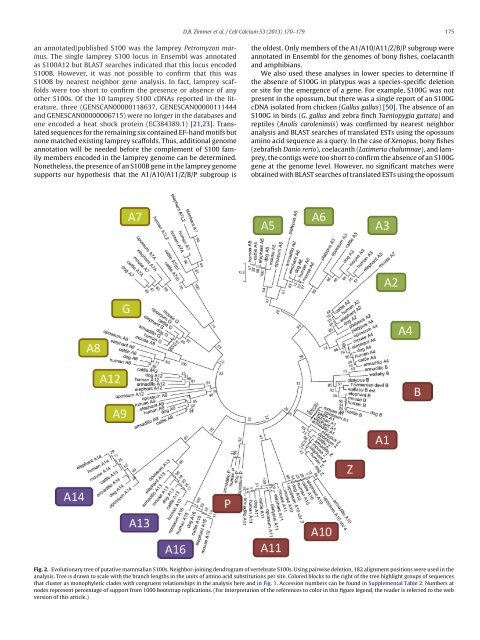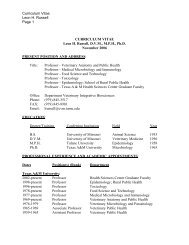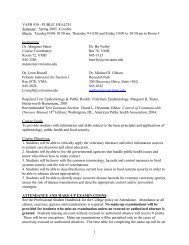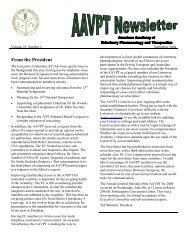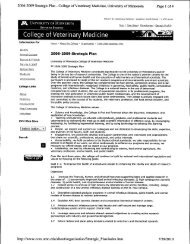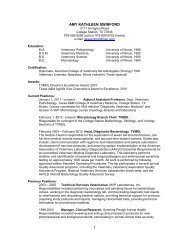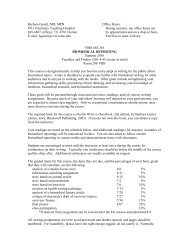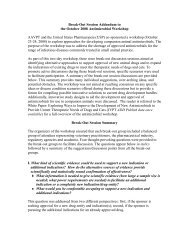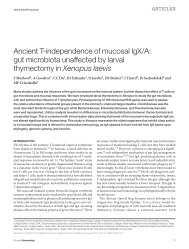View PDF - College of Veterinary Medicine - Texas A&M University
View PDF - College of Veterinary Medicine - Texas A&M University
View PDF - College of Veterinary Medicine - Texas A&M University
You also want an ePaper? Increase the reach of your titles
YUMPU automatically turns print PDFs into web optimized ePapers that Google loves.
an annotated/published S100 was the lamprey Petromyzon marinus.<br />
The single lamprey S100 locus in Ensembl was annotated<br />
as S100A12 but BLAST searches indicated that this locus encoded<br />
S100B. However, it was not possible to confirm that this was<br />
S100B by nearest neighbor gene analysis. In fact, lamprey scaffolds<br />
were too short to confirm the presence or absence <strong>of</strong> any<br />
other S100s. Of the 10 lamprey S100 cDNAs reported in the literature,<br />
three (GENSCAN00000118637, GENESCAN00000111444<br />
and GENESCAN00000006715) were no longer in the databases and<br />
one encoded a heat shock protein (EC384389.1) [21,23]. Translated<br />
sequences for the remaining six contained EF-hand motifs but<br />
none matched existing lamprey scaffolds. Thus, additional genome<br />
annotation will be needed before the complement <strong>of</strong> S100 family<br />
members encoded in the lamprey genome can be determined.<br />
Nonetheless, the presence <strong>of</strong> an S100B gene in the lamprey genome<br />
supports our hypothesis that the A1/A10/A11/Z/B/P subgroup is<br />
D.B. Zimmer et al. / Cell Calcium 53 (2013) 170– 179 175<br />
the oldest. Only members <strong>of</strong> the A1/A10/A11/Z/B/P subgroup were<br />
annotated in Ensembl for the genomes <strong>of</strong> bony fishes, coelacanth<br />
and amphibians.<br />
We also used these analyses in lower species to determine if<br />
the absence <strong>of</strong> S100G in platypus was a species-specific deletion<br />
or site for the emergence <strong>of</strong> a gene. For example, S100G was not<br />
present in the opossum, but there was a single report <strong>of</strong> an S100G<br />
cDNA isolated from chicken (Gallus gallus) [50]. The absence <strong>of</strong> an<br />
S100G in birds (G. gallus and zebra finch Taeniopygia guttata) and<br />
reptiles (Anolis caroleninsis) was confirmed by nearest neighbor<br />
analysis and BLAST searches <strong>of</strong> translated ESTs using the opossum<br />
amino acid sequence as a query. In the case <strong>of</strong> Xenopus, bony fishes<br />
(zebrafish Danio rerio), coelacanth (Latimeria chalumnae), and lamprey,<br />
the contigs were too short to confirm the absence <strong>of</strong> an S100G<br />
gene at the genome level. However, no significant matches were<br />
obtained with BLAST searches <strong>of</strong> translated ESTs using the opossum<br />
Fig. 2. Evolutionary tree <strong>of</strong> putative mammalian S100s. Neighbor-joining dendrogram <strong>of</strong> vertebrate S100s. Using pairwise deletion, 182 alignment positions were used in the<br />
analysis. Tree is drawn to scale with the branch lengths in the units <strong>of</strong> amino acid substitutions per site. Colored blocks to the right <strong>of</strong> the tree highlight groups <strong>of</strong> sequences<br />
that cluster as monophyletic clades with congruent relationships in the analysis here and in Fig. 1. Accession numbers can be found in Supplemental Table 2. Numbers at<br />
nodes represent percentage <strong>of</strong> support from 1000 bootstrap replications. (For interpretation <strong>of</strong> the references to color in this figure legend, the reader is referred to the web<br />
version <strong>of</strong> this article.)


